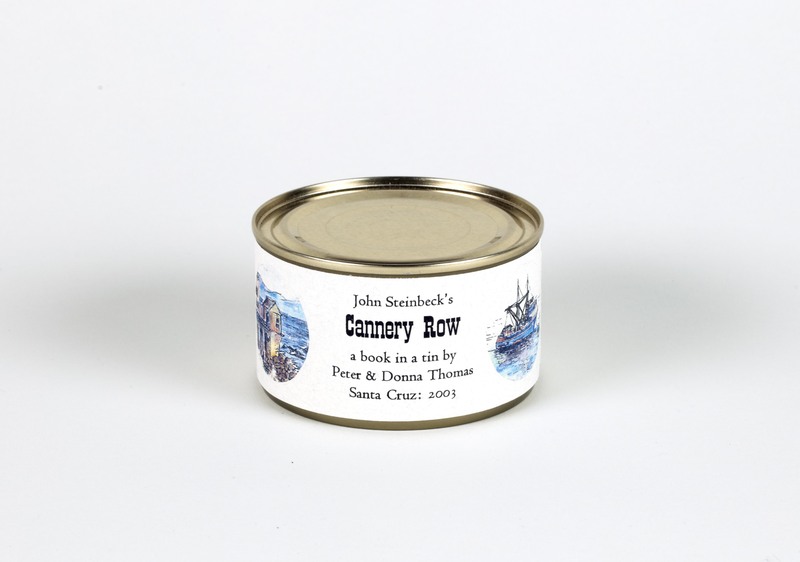A116. Cannery Row
A116. John Steinbeck. Cannery Row. Santa Cruz, California: Peter & Donna Thomas, 2003.
82.5 x 51 mm (3 ¼” x 2”), 14-page accordion, 100 copies.
Binding: Simple accordion; covers are galvanized iron. Covers and pages are circular. Title on label on cover. Book is sealed inside a tin can packed with shredded paper. Title and publication information are printed on a paper label on the can. All paper used for the binding handmade by Peter Thomas. Paper: Duplex sheet; white on front with green net-like paper pulp pattern on reverse, handmade by Peter Thomas. Printing: Text is letterpress. Illustrations are digital. Typography: Hand set Centaur. Illustration: Reproductions of eight watercolor paintings by Donna Thomas. Notes: Label contains warning: “Please be careful not to injure yourself on the tin while removing this book.”
“The text is the opening paragraph of Cannery Row by John Steinbeck, and the choice of text led us to the idea of placing the book in a sealed tin can. To see the book, the can must be opened with a can opener, presenting the owner with a dilemma: do they want their artwork to be ‘original’ and leave the can sealed, or do they open the can to see the book inside. We had hoped to use a sardine tin, with the little key to open it, but could not find a source. During the search we found a local business, Dave’s Albacore, which had an old canning machine salvaged from Cannery Row. They were willing to can the book for us, saying ‘drop it off on a Friday and we will can the books first thing Monday morning, and hopefully that way they won’t smell too much like fish.’
After deciding to can the book, we began designing other elements to also reference Steinbeck’s Cannery Row. In preparation for making the illustrations Donna first went to the Steinbeck museum to look at old photos then went to Cannery Row to paint the eight watercolor paintings. Wanting full color illustrations, we decided to digitally print the images, and wanting crisp printing we decided to print the text letterpress. This required overcoming a specific technical limitation of digital printing, as photocopy machines have no method for registration. Our solution was to first digitally print the images, then trim each sheet square to the images before letterpress printing. The book was bound between two galvanized iron covers referencing the tin and iron canneries mentioned in the text. Effort went into treating the metal so it would not rust or affect the archival qualities of the paper. This was the first of our books to be featured in a major museum show, at the Whitney in Minnesota.”
